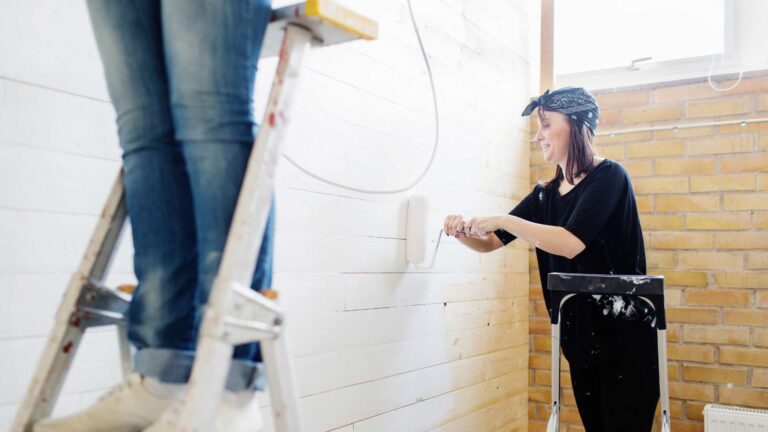Table of Contents
From kitchen upgrades to full revamps, planning for home renovations feels all fun and Pinterest boards until surprise costs pop up. When you bring your dream plan and action, you encounter hidden fixes, upgrades, and expenses you were never prepared for. That’s why thoughtful financial planning plays an essential role.
Read this blog for an outline of how to plan, budget, and fund your project without financial stress. Whether it’s that dream gaming room or fixing the leaking roof, knowing how you will pay for it helps you stay in control.
Step 1 – Define the Scope of Your Renovation Project
The first and most crucial part of your renovation project is knowing what needs to be renovated so that you can envision what you want and how you want your home to look.
Decide What You’re Renovating
Before the renovation, get a clear picture of what you want to change. For example, specify what you want to change if you renovate the kitchen. Is it the furniture, or do you wish to install a chimney, set up a new stove, or just change the exterior part?
Before you allocate a budget, be specific about the types of renovation, whether you want to make major revamps or just look for minor fixes, because your expenses will depend on it. Having a clear plan helps you set the budget easily. It is worth investing time in deciding what you need and avoiding unnecessary upgrades and outlays.
Determine Must-Haves vs. Nice-to-Haves
When planning your home renovation, having a list of must-haves vs. nice-to-haves is good. Note what is essential, like fixing old plumbing, adding storage, or creating space for a growing family. Next, list items you desire to have but can live without, such as fancy light accessories or trendy terminations. This keeps your budget on track without spending too much money.
Read related blog: Can You Use a HYSA to Save for Home Renovations?
Step 2 – Create a Realistic Renovation Budget
Once you decide what to upgrade or change, you should set a budget for the renovations.
Get Multiple Estimates
It’s always a brilliant idea to research well, contact several renovators, and get quotes from them. Compare these quotes, identify what is included in the contract and what is not, and then shortlist the one that matches your requirements and budget. Getting multiple estimates allows you to make informed decisions.
Add a Contingency Buffer (10–20%)
During renovation, unexpected costs can pop up more often than you think. There can be hidden damages, sudden price changes, or last-minute upgrades. Adding a contingency buffer of around 10-20% to your budget is wise. These buffers can manage surprises and give you peace of mind if things don’t go as planned.
Read related blog: Zero Interest Home Improvement Loans
Step 3 – Breakdown of Typical Renovation Costs
After you have a quotation, you have a rough idea of the money you might need to spend, but if you expand your budget and make it more detailed, you can be better prepared for unexpected costs.
Labor vs. Materials
Do you want to know where your money is going, especially regarding labor and materials? When planning your renovation budget, labor costs comprise a bigger portion of the total budget. They cover things like skilled work, installations, and project management. At the same time, materials include everything from tiles to paints to fixtures. These costs help you differentiate your spending and where to cut costs or adjust based on your priorities.
Permits, Fees, and Inspections
Inspections and permits also need to be considered because these fees are unavoidable, but generally go unnoticed during budgeting. You might save time and money now by skipping them, but this can lead to troubles like fines or delays. Based on your projects, you need permits for plumbing, electrical work, and structural changes. From the start, you should always check local rules and include these costs in your budget. It’s not worth the risk.
Read related blog: The Importance of Budgeting for Medical Emergencies
Step 4 – Explore Funding Options for Home Renovation
If finances are the only obstacle between you and your dream home, you can always look for a reliable funding option that is both trustworthy and flexible in its repayment options.
Savings or Emergency Funds
It is easier to use your savings and emergency funds to make payments for renovations, especially if you are planning. You don’t have to worry about loan applications, interest, and monthly payments, as you use the money you have already saved. Remember that you are draining your emergency funds completely. You should leave some amount for emergencies.
Home Equity Loan or HELOC
If you have built up value in your home, a home equity loan (HELOC) helps you borrow money against it. In a Home Equity Loan, you get a lump sum once and then pay this fixed amount each month. A HELOC is more flexible because you can borrow money as needed and then pay it back over time. Both are useful, but it depends on your needs, and at times, there can be tax benefits.
Personal Loans
Personal loans are an excellent choice for small renovation projects if you require funds quickly. They are unsecured loans, so you don’t have to use your house as a guarantee. They are easy to manage as they involve fixed interest and monthly payments.
Remember that using a personal loan can affect your credit score, and the current interest rate can be higher than in the past year. Beem finds the best personal loan offers for you. You can compare and see what works for you and move ahead with it.
Credit Cards (Use Cautiously)
Looking for funds that can manage your small renovation projects, especially if you have 0% APR offer or just want to earn rewards? Credit cards are best considered, but they must be used cautiously. High interest rates can accumulate quickly if you cannot pay the amount on time. If you use credit cards, make a clear repayment plan beforehand to avoid trouble.
Read related blog: Budgeting for Major Life Changes: Marriage, Baby, and Moving
Step 5 – Cost-Saving Tips for Major Renovations
Home renovations don’t always need to be heavy on your pocket; you can use your creativity, upcycle old stuff, or repurpose existing stuff.
DIY What You Can
If you are creative and can DIY some areas of the house during the renovation, this can help you reduce expenses. You don’t have to be professional; you just have to paint a wall, demolish, or install shelves. However, some tasks require professionals, such as electrical, plumbing, or structural work. So, if you can DIY some parts of your house, go for it; this will give your home a new look and can save you money.
Reuse or Repurpose Existing Materials
So many items can be reused or repurposed with the existing material, which helps you save money. During renovation, you can check out cabinets, frames, and fixtures requiring little shine, polishing, and painting. This can give them a new look. You can also repurpose old doors or windows into fresh designs. This can reduce waste and costs incurred on purchasing new materials to give your home a unique look, which can be done with the help of reuse and repurposing.
Schedule Off-Season Work
Scheduling your home renovation during the off-season reduces your expenses. Contractors less busy in winter or right after the holidays can give you discounts to fill up their schedule. You might also get faster timelines as there is less demand during this period. The work you’re planning should be done in that season because some outdoor projects might need to wait. Planning smartly around the calendar can lead to better prices and less stress during your renovation.
Read related blog: What Are Home Improvement Loans? Best Answers
Step 6 – Know How to Monitor and Manage Expenses During the Project
If you want to keep a check on your budget, you should know how to manage your expenses.
Use a Renovation Budget Tracker
A renovation budget tracker helps you stay on top of your spending. Whether it’s a simple spreadsheet or a budgeting program, tracking costs against your planned budget helps you spot overspending. It also keeps everything organized, so you are not guessing where your money went. A little habit of tracking can go a long way in avoiding budget surprises.
Beem’s Budget planner can help you plan and save money like an expert with on-point financial insights and recommendations. Download the app now.
Avoid Change Orders When Possible
When you change your mind too often during renovation, it can get costly. Every small change adds extra time, materials, and labor. So, it is best to stay on the plan once the work begins. That’s why you should finalize the design early to avoid last-minute changes. Your budget and contractor will thank you for this.
Step 7 – Understand ROI and Long-Term Value
Everyone loves stylish and dreamy interiors, but think wisely and ask yourself about the long-term value of the expenses you have made.
Not All Renovations Boost Home Value Equally
Do all renovations add the same value to your home? Then you are wrong. For example, if your project includes kitchen upgrades, it offers a good return on investment (ROI). It is essential to think about what adds value to your house. Make updates that improve both your space and the future resale value of your home.
Think Long-Term Maintenance and Energy Efficiency
You can focus on the upfront costs, but long-term costs matter, too. It is smart to choose energy-efficient materials that provide you with benefits in the long run. These help you reduce your utility bills and future repairs. Although it costs more right now, you will witness the results in the future. Planning helps you build a home that is budget-friendly.
Read related blog: Budgeting for Holidays and Special Events: The Complete 2025 Guide
FAQs – Budgeting and Funding for Home Renovation
What’s the best way to finance a large renovation?
You can finance extensive renovations with a home equity loan or HELOC if you have equity. These loans are perfect for renovations with higher costs, lower interest rates, and flexible terms and conditions.
How much should I set aside for unexpected costs?
To avoid stress when unexpected costs pop up, you should set aside 10-20% of the total budget for renovation. These unexpected costs can be a sudden rise in the price of the materials or hidden damage, etc., which can cause big problems. So, to avoid this, you should be ready with this buffer amount.
Can I use a personal loan for home improvement?
Yes, a personal loan for home renovation can be used if the loan is under $50,000. It is an unsecured loan, so you don’t have to worry about using your home as a guarantee.
How do I prioritize renovation tasks on a tight budget?
To prioritize renovation, note essential items, such as safety issues, structural problems, leaks, wiring, or damage. Then, focus on things that add value to your house, such as the kitchen or the bathroom.
Are there tax benefits for renovations?
Yes, there are tax benefits for energy-saving improvements like solar panels. According to IRS regulations, these are qualified for credits.
Should I get multiple contractor quotes?
Yes, get 2-3 quotes from different contractors. This will help you compare costs and make the best decision before you begin your home renovation, which stops you from overspending.
Is DIY renovation worth the savings?
You can save on labor costs by doing DIY projects like painting or putting up a shelf. However, you should avoid changes that require professional help, such as structural, electrical, or plumbing.
What are the signs of a good contractor?
A good contractor should be professional, have a license, be committed to providing quality work, and be able to complete work on time, or have good client reviews.
When is the best time of year to start renovations?
The best time to start renovations is spring, winter, or autumn. These months provide suitable weather conditions and contractor availability, which can suit your budget. However, the type of job and location will affect how long your renovation will take.
Renovate With Confidence by Budgeting Wisely
A home renovation comes with several challenges, but if you have a proper plan ready, it can reduce your stress. Follow the steps mentioned above to avoid financial problems. Set clear goals and budgets, and make the right financing choices. This will help you complete the home renovation project you dream of.















































